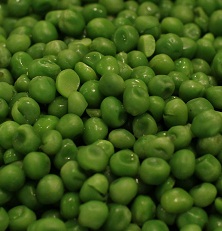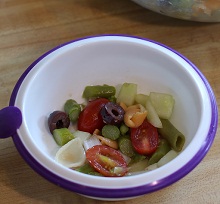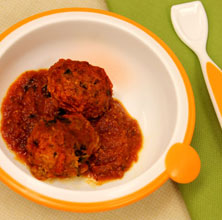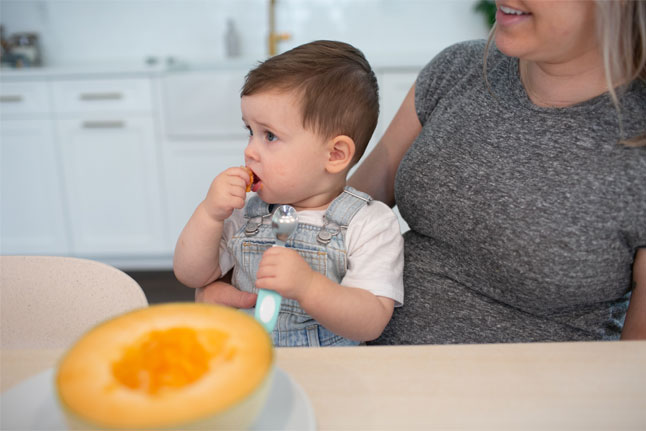Stage 3

- 10 oz package of frozen peas
- 4 cup vegetable stock or chicken stock
- 1 whole clove of garlic, minced
- 1 whole carrot, chopped
- 1/2 cup onion, chopped
- 1 roma tomato, chopped
- 1 small parsnip, chopped
- 1 tsp rosemary
- 1 tsp butter or olive oil
- Salt and pepper to taste
Rough chop all vegetables, sauté in a small stock pot with butter or olive oil and season with salt, pepper and rosemary. Add 3 cups stock or water, bring to boil add peas and reduce heat to a simmer for 8-10 minutes. Remove from heat and cool slightly before blending to desire consistency, for a smoother puree add the remaining cup of stock.
Serve hot or cold and share this fun dish with your toddler along with the rhyme:
“Pease porridge hot, pease porridge cold, pease porridge in the pot 9 days old. Some like it hot, some like it cold, some like it in a pot 9 days old.”
Recipe Yields: 4 Servings
Storage Time: 5 days in the refrigerator
This recipe is a great source of vegetables and is rich in vitamins and nutrients. In addition, green peas are rich in antioxidants and offer anti-inflammatory benefits.
Stage 5

This recipe is packed with veggies, flavor and bright colors.
- 1/3 cup pasta, any fun shape your child likes
- 1 cup asparagus, chopped
- 18 grape tomatoes, cut in half
- 1/8 cup red onion, diced
- 1- 5oz mozzarella ball cut into cubes or 1/3 cup small mozzarella balls
- ½ cucumber peeled, seeded and cut into small chucks
- 4 black olives, sliced
- 1 tbsp honey
- 3 tbsp extra virgin olive oil
- 1 tbsp soy sauce
- 1 tbsp red wine vinegar
- salt and pepper to taste
Cook pasta according to box, during the last 5 of pasta boiling add asparagus to boil. Drain and rinse with cold water. While the pasta and asparagus is cooking, whisk together all dressing ingredients. Place all of the salad ingredients in large bowl and toss together with teh dressing.
Recipe Yields: 4-6 Servings
Serve immediately or chill and serve later.
Storage Time: 3 days in the refrigerator
This pasta salad recipe contains valuable vitamins and nutrients. One of the main ingredients in this recipe is asparagus. Asparagus provides antioxidant nutrients, including vitamin C, vitamin E, beta-carotene and several minerals including zinc and manganese. In addition, asparagus is a heart healthy vegetable that rich in fiber and aids in digestive support.
Stage 5

The combination of lean turkey and kale helps each meatball to pack a nutritional punch, and the inclusion of fresh basil is a nice way to introduce your toddler to a new flavor.
- 1 lb ground turkey
- 1 1/2 cups finely chopped kale leaves (without stems)
- 1 tbsp shredded parmesan
- 1/2 cup whole grain bread crumbs
- 1 tbsp fresh basil leaves
- 1/4 tsp salt
- 1/4 tsp pepper
- 1 whole egg
- 1/4 cup cottage cheese
- 3 cups marinara sauce
Combine turkey, kale, parmesan, bread crumbs, basil, salt and pepper.
Incorporate egg with meat mixture.
Incorporate cottage cheese with meat mixture.
Spray inside of slow cooker with nonstick cooking spray.
Roll the turkey mixture into 2-inch balls and place in your prepared slow cooker.
Pour the marinara sauce over the meatballs. You can use a prepared marinara sauce for this recipe. Just look for one that does not have a lot of added sugar or preservatives.
Cover and cook on low for 5-6 hours.
Serve over pasta, with sautéed zucchini slices or even cauliflower mash.
Recipe Yields: 6 Servings
Storage Time: 3 days in the refrigerator
Turkey is a potent source of lean protein and iron, and kale is an excellent source of vitamins A,C, and K.
Stage

The ABCs Of Vitamin C
Vitamin C is critical for health and growth in infancy. This essential vitamin promotes a strong immune system, the growth and maintenance of healthy skin and red blood cells, plus is necessary to build collagen, which helps to form connective tissue that binds muscles, bones, and tissue together. Vitamin C is also known to increase wound healing, while preventing infections and, as an antioxidant, helps protect against diseases such as cancer, heart disease, and arthritis in the future.
While you may have heard these important vitamin C facts from your pediatrician, it may come as a surprise to learn of the many unexpected ways to ensure your little one is getting adequate amounts of vitamins. When baby starts using solid foods as their primary source of nutrition, they should consume foods high in vitamin C daily. Note that most pediatricians suggest infants 7 to 12 months should consume 50 mg. of vitamin C a day, while children 1 to 3 years should have at least 15 mg. a day. To ensure your baby is getting enough vitamin C, try some common (oranges) and uncommon (zucchini) with them. Let’s take a look at some of the common and uncommon sources of vitamin C.
Citrus fruits.
You probably already know about this vitamin C option. Oranges, lemons, grapefruits, and tangerines are just a few of the many types of citrus fruits. They’re well-known for their high vitamin C content. Diluting the juice in water, pureeing, or simply eating the fruit as is-are all excellent ways to introduce your child to these sweet, colorful, and vitamin C-rich foods.
Tomatoes.
Foods like pizza, spaghetti, tomato soup and even ketchup are known to be loved by most little ones. Believe it or not these tomato-based foods are all sure-fire ways to get your little one to sneak in some extra vitamins, including vitamin C! For instance, a 10-ounce serving of tomato soup offers 6.4 mg. of vitamin C. Tomatoes are versatile, try a couple of varieties with your little one to find which they like best.
Sweet potatoes.
This bright and sweet vegetable is ideal for when your baby first begins to eat solids. They contain a wide range of nutrients and can be prepared in a variety of ways. A common way for parents to introduce sweet potatoes is during baby-led weaning, by cooking and mashing them to an appropriate consistency. As your little one progresses in their solid food journey, experiment with different preparations, such as sweet potato French fries.
Cantaloupe.
This child-popular melon is also a great source of vitamin C. A sweet fruit option that can be introduced to baby as soon as they begin eating foods like purees. It’s rich in vitamin C and other essential vitamins. Just one-quarter of a medium cantaloupe features an eye-opening 47 mg. of vitamin C This fruit’s preparation is critical because it can pose a choking hazard if not done correctly.
Watermelon.
Watermelon is a nutritious treat for your little one that is sweet, juicy, and contains approximately 92%1 water. It’s rich in antioxidants, including vitamin C, which can help strengthen baby’s immune system. Like many of the other fruits listed, there is a variety of ways to introduce your little one to this delicious fruit.
Zucchini.
Just one cup on zucchini contains 11 mg. of vitamin C and helps add even more healthy variety to your child’s daily diet. Zucchini can be roasted, steamed, sautéed, or pureed. Pureeing it and making it a sauce with pasta is a sneaky way to sneak this vegetable into your child’s diet (especially if they’re picky).
While offering your toddler a piece of fruit with each meal is a good idea, try introducing other lesser-known sources of vitamin C, such as those listed above, to help provide your toddler with a well-balanced diet that provides multi-vitamin and nutritional benefits.
Stage 5

- 1 whole wheat sandwich round or pita
- 1/4 cup Pizza sauce
- 1/4 cup Mozzarella cheese, grated
- 1/4 cup Mushrooms, sliced, cooked and cooled
- 1/4 cup Zucchini, sliced, cooked and cooled
- 1/4 cup Sweet red pepper, sliced, cooked and cooled
- 1/4 cup Spinach, cooked and cooled
Open up sandwich round or pita and spread pizza sauce onto both halves.
Put each of the cooked vegetables into small bowls. Have your child choose toppings from the bowls to build their favorite pizza.
Top each pizza with grated cheese.
Bake both pizzas on a cookie sheet at 400 degrees Fahrenheit for 5-7 minutes, or until cheese is melted. Let cool and serve.
Recipe Yields: 2 Servings











